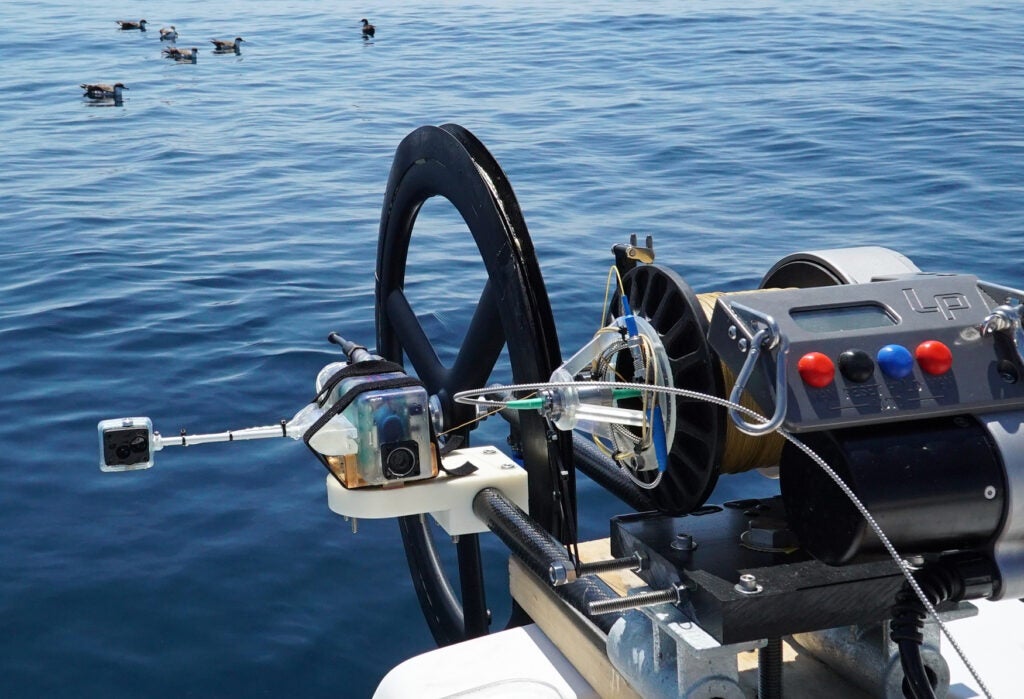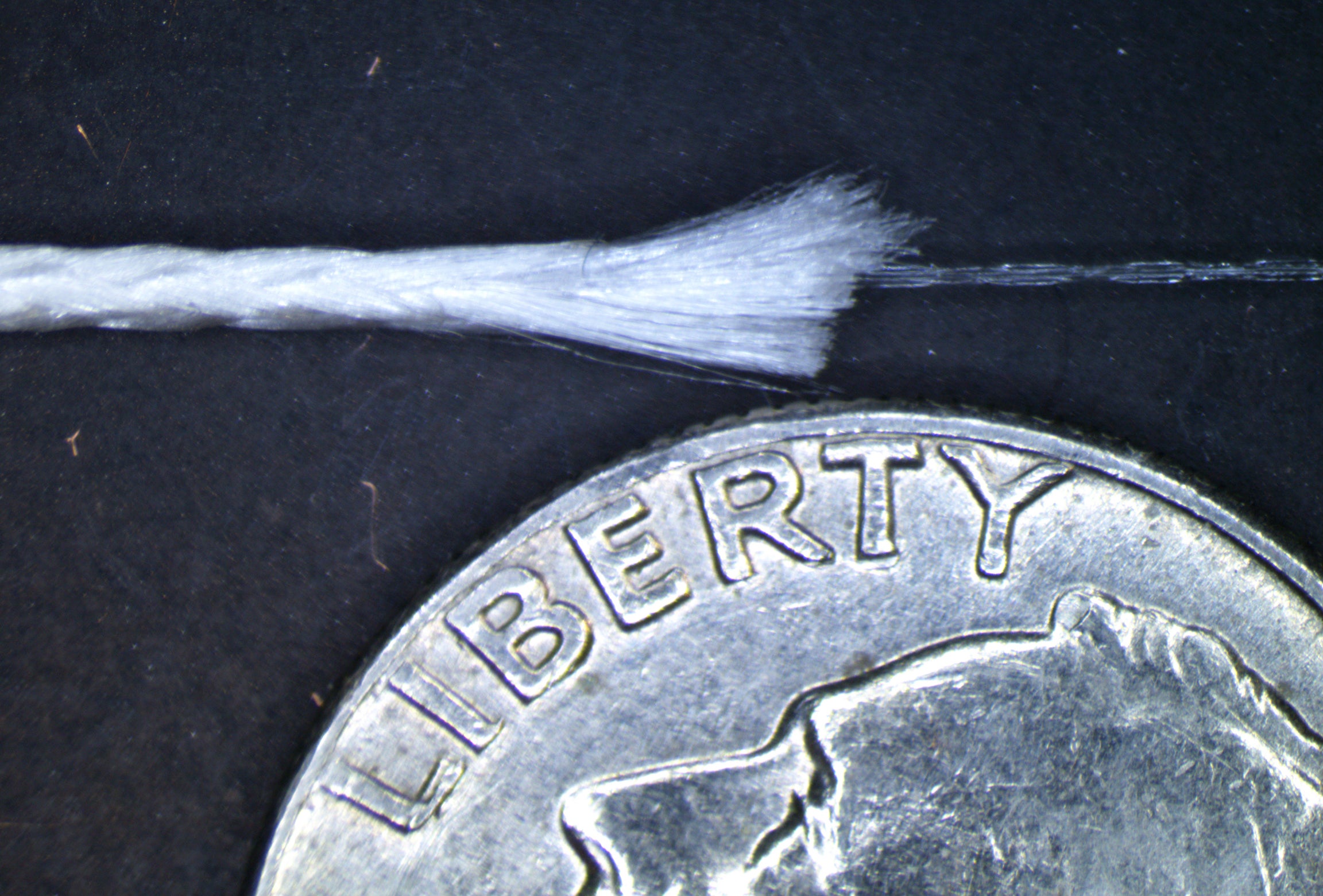URI engineering professor produces smallest deep-sea system in the world that can provide a livestream video feed
The answers to many of life’s mysteries have been discovered far below the surface of the seas.
However, getting to those depths has not been easy.
Thanks to a new fiber optic reel system invented by Brennan Phillips, an assistant professor of ocean engineering at the University of Rhode Island, deep-sea exploration is about to get much more affordable and accessible.
Shrinking the System
Having worked on large research vessels all over the world,
Phillips is well aware of the expense, planning and massive scale involved in
deep-sea exploration.
“If you have a large underwater vehicle that you’re using,
you need several people to run it and a large research vessel to operate it,
which is very expensive,” said Phillips. “By making the vehicles smaller, the
cables smaller and the winches smaller, we can save a lot of money and go more
places in the world.”
The fiber optic fishing reel system with a live-telemetry
fiber optic imaging payload prepared for deployment in deep water over Atlantis
Canyon in July 2020. Photo courtesy of Brennan Phillips
Two years ago, Phillips created a
miniature, inexpensive deep-sea camera system called DEEPi. However, he still had to rely on a
large research vessel to get it in the ocean. That led to his development of a
small deployment system.
“It all comes down to the diameter of the cable,” said
Phillips. “A cable that is three-quarters of an inch in diameter ends up
weighing many tons when you have 4,000 meters of it, which means you need a
massive winch to go with it. If you make the cable smaller, everything scales
down accordingly.”
The fiber optic fishing reel system with an imaging payload deployed
in deep water over Atlantis Canyon in July 2020.
Photo courtesy of Brennan Phillips.
After experimenting with a custom-designed cable that was
still too wide, Phillips ended up using something that can be spotted all over
Rhode Island in the summertime, a fishing reel.
“I wanted to get to the point where I had a winch that could
get me somewhere deep in the ocean, but I could carry it in a suitcase,” said
Phillips. “An electric fishing reel is essentially a miniature winch and it’s
available off the shelf.”
Collaborating with Industry
Having solved the scale issue, Phillips’ next step was to
figure out how a cable small enough to wrap around a fishing reel could
transmit data, including video, in real time while underwater.
“We didn’t have a cable that size with fiber optics in it
for data transmission, so we had to invent it,” Phillips said.
Not having the necessary equipment to integrate the fiber
optics in the fishing line, Phillips requested the help of Jim Owens, principal
of Nautilus Defense in Pawtucket.
“When I told Jim that I wanted to a make fiber optic fishing
line, I thought he would say ‘that’s impossible’ or ‘I can’t do it,'” said
Phillips. “But he surprised me by saying, ‘I think we can do that.’ A week
later he mailed me a prototype.”
“Brennan had very clear parameters and objectives for the
system and he let us run with our part of the project,” said Owens. “We
developed a fiber optic tether that was mass and volume-efficient using our
in-house braiding equipment.”
With the fishing reel and fishing line now at the same scale as the deep-sea camera he previously developed, Phillips successfully produced the smallest, most compact deep-sea system in the world that can provide a livestream video feed.
The fiber optic reel system is described in the April 2021
issue of Sensors. Co-authoring the journal article
with Phillips were URI ocean engineering students Nicholas Chaloux and Russell
Shomberg; Adriana Muñoz-Soto, who did an internship on the project for the
University of Puerto Rico Mayagüez; and Owens.
Phillips and Owens have filed for a provisional patent for
the fiber optic reel system, with the application being sponsored by
URI and Nautilus Defense.
Putting it to the Test
Phillips began working on the fiber optic reel system before
the pandemic started, but did the bulk of the testing during the pandemic.
In the summer of 2020, he deployed the system a couple of
times in the Narrow River in Rhode Island, where the water was calm and flat.
He used his own personal boat for the test. Another conducted another test in
Narragansett Bay, near Newport.
The first deep-water test took place later in the summer on
a day-long boat trip to Atlantis Canyon, 100 miles off the coast of Falmouth,
Massachusetts.
“Because of the pandemic, a lot of larger boats were
inaccessible at that time,” said Phillips. “But because we had this compact
reel system, we could do the trip with just three people – me, the captain and
one of my students – and still be COVID-safe.”
At a depth of 350 meters, the system successfully
transmitted live video throughout the cast, capturing footage
of euphausiid shrimp, anemones, benthic fish, and other organisms and
phenomena, including flashes of bioluminescence.
The reel system was tested at a much greater depth in
December of 2020 in Bermuda, reaching 780 meters. Like the previous tests, the
system was deployed and retrieved without any issues.
“The results were better than I expected,” Phillips said. “I
never truly believed it would work because the system includes several
components that have never been tried before. I’m sure I screamed at the top of
my lungs when it actually worked.”
Portability Saves on Expense
Since the fiber optic reel system is a fraction of the size
and weight of a system using a traditional winch, cable and camera, a much
smaller boat can be used to transport the system.
“We can use a fishing boat to get this new system deep in
the ocean instead of a 100-foot vessel,” said Phillips. “That means each time
we go out on the water, we’ll be saving many times what it would normally cost
for an operation.”
Potential Applications
For researchers such as Phillips, the fiber optic reel
system will be a quick, low-cost way to get a camera, sensor or physical
sampling device that needs data transmission down deep in the water. But
scientists won’t be the only ones who could benefit from a system with these
specifications.
“Currently, there isn’t a way to deploy deep-sea
equipment using an autonomous vessel or a drone using a winch that weighs
several thousands of pounds,” said Phillips. “But the U.S. Navy would
probably have some interesting applications for something that is much smaller
and more compact.”
As a commercial product, the system could be a game-changer
for the fishing industry.
“There would be a lot of benefits to be able to see what
your bait or lure is seeing, especially deep in the ocean,” said Phillips.
“There are a couple of systems on the market that can take pictures or record
video, which you can watch later, but this system would provide live video,
enabling the person who is fishing to adapt on the fly to what they are
seeing.”
Educational Benefits
Phillips won’t have to look far to see the reel system put
into use. He expects engineering students at URI to find many creative ways to
apply it to projects.
“If we have this compact reel system that can be taken out
on any boat on any day, it’s really great for students because they can make
all types of stuff to go on it,” said Phillips. “We can enable students to make
their own deep-sea equipment using this type of system.”
Phillips is excited to see what the students will come up
with.
“When I look around my lab, I see a bunch of successful and
failed projects that students designed,” said Phillips. “That’s how good
engineering happens, through trying and failing.”
